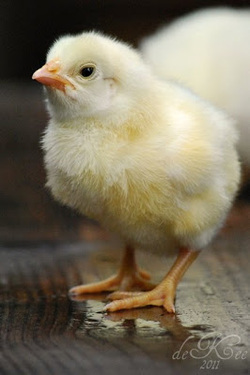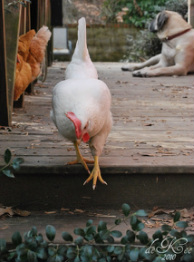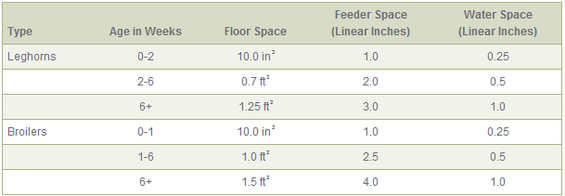General Chicken Management

What You Need To Start Them Right
1. Chick Starter:
a. Layers: 280 pounds per 100 chicks
b. Broilers: 250 pounds per 100 chick
2. Chick Feeders: minimum of one foot long per 15 chicks
3. Water Fountains: one gallon capacity per 25 chicks or ¼ inch trough space per chick.
4. Heat Lamp: 75 birds per heat lamp with a minimum of two lamps of 90w -250w.
5. Litter: About four inches of pine shavings or sawdust
6. Chick Guard: 18 to 24 inch cardboard, a stock tank, or kids swimming pool to keep chicks confined close to heat, feed, and water for first 10 - 20 days.
|
Chickens
Egg Production Breeds: Several efficiency egg laying strains are available. Leghorns, Golden Comet, etc. start laying eggs at about 20 weeks, at which time they weigh about 3 pounds. With proper management, they will lay 18 to 22 dozen eggs per bird during the first year of production. The heritage egg strains will weigh about 4 pounds by 20 weeks of age. They come in a variety of feather color patterns and will generally produce somewhat fewer eggs while requiring more feed than the efficiency egg layer breeds. They are generally classified as dual purpose breeds with the cockerels used for meat production and the hens for egg production. These girls tend to have great personalities and will go broody and set eggs for hatching for you. Meat Production Breeds - There are commercial broiler strains of Cornish and White Rock breeding however, I suggest that you look into raising a more ethical breed such as Freedom Rangers or Kosher Kings. They often may be purchased as straight run or on a sexed basis. |
. |
Preparing for Bird Arrival
- Remove all old litter.
- Clean and disinfect house and equipment using an approved disinfectant.
- Fumigate if possible.
- Let house lie empty and air out for two weeks.
- Place about four inches of clean, dry litter such as pine shavings or sawdust.
- Use chick guards to keep birds close to heat, feed and water. Prevent drafts and piling for the first 10 days.
- Bring house up to brooding temperature one day before delivery.
- Fill waterers 4 hours before arrival. Allow birds to drink for 3 to 4 hours before giving first feed. This will help prevent dehydration.
Culling

It is always a good idea to cull and destroy sick or lame birds. These birds are generally inefficient because they do not grow or produce eggs while continuing to eat feed.
By the end of the first production cycle (10 to 12 months of lay), many laying hens will naturally quit producing eggs and molt. These hens could be removed and slaughtered for meat, if desired. Birds in laying condition will have a large, bright, waxy-appearing comb, moist vent and flexible keel and pubic bones that are wide apart.
Non-layers will have a dull, small comb and dry vent with rigid keel. The distance between the pubic bones will be only 1 or 2 finger widths, while 3 or 4 fingers will easily fit between these bones of a bird in laying condition.
Leghorn hens may be molted (rested) after their first production cycle. After 4 to 8 weeks of resting, the hens will return to production at a production rate somewhat less than their first cycle.
Chick Brooding
Brooder warmers or heat lamps can be utilized. Place a maximum of 75 birds per heat lamp. Use a minimum of 2 heat lamps in case one burns out. Adjust the temperature to 90° at the chick level. Reduce temperature 5° per week to a minimum of 60° F. The best indication of a comfortable temperature is when the chicks are spread evenly within the chick guard. Remove wet areas around waterers and feeders daily to maintain good litter condition and to keep leg problems and disease conditions at a minimum. Brooder litter paper should be used when starting chicks. It makes it easier for the chicks to get around and reduces the chicks’ tendency to eat the litter, causing starve-outs
Chick Light Management
The effect of light on growth and production is a very important factor. Chicks should be placed on 24 hours of light for the first week. Broilers and capons can then be allowed to follow the natural day length as long as there is at least 14 hours of light provided.
General guidelines for total of natural and artificial light could be as follows:
- First week after chicks are housed - 24 hours of light.
- 2 to 6 weeks - 16 hours of light.
- 6 to 12 weeks - 13 hours of light.
- 12 to 18 weeks - 10 hours of light.
Use one 60-watt bulb for very young birds. One 25-watt bulb (per 200 square feet of floor space) is adequate for growing pullets, broilers and capons.
Temperature and Ventilation
The optimum temperature range for birds over 4 weeks of age is 65°-75° F. As temperature gets above or below this range, the production, growth rate or efficiency can suffer. To control temperature, ammonia, humidity, dust, disease and litter condition, fresh air movement is essential. Approximately 5 to 10 times as much ventilation is needed in warm temperature conditions as in cold conditions.
Egg Storage and Cleaning
Eggs should be gathered several times per day. Wash, dry and cool them as quickly as possible to maintain freshness. The wash water should be the same as the temperature of the eggs. Soap and water are fine for washing eggs. Store eggs at approximately 50° F and 70 percent relative humidity.
Roosting and Nest Space
Roosts may be used for growing or mature birds, although they are not essential the chickens prefer them. Allow 6 inches of roost space per bird. To keep eggs clean, nests must be provided for laying hens. Allow 1 nest for every 4 hens. To prevent floor eggs, put nests in darkened area of the house. Keep the nests filled with adequate amounts of litter to prevent egg breakage and dirty eggs.
Space and Equipment Requirements
(Absolute Minimums Per Bird)






